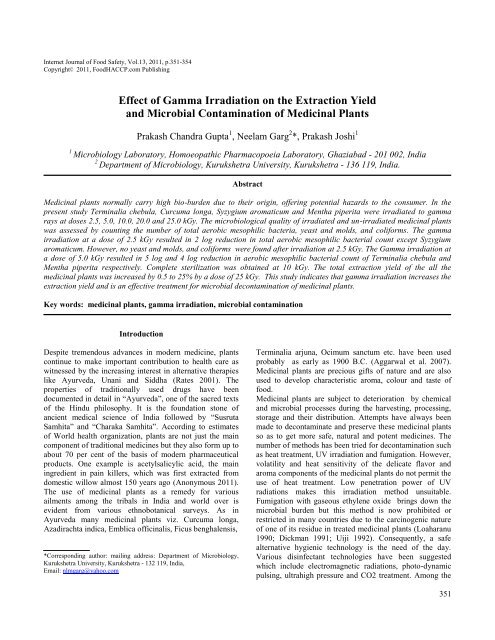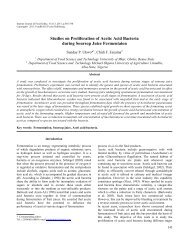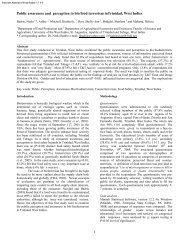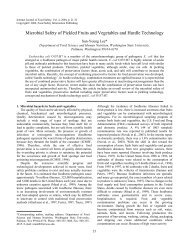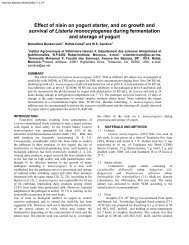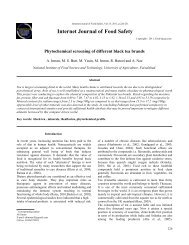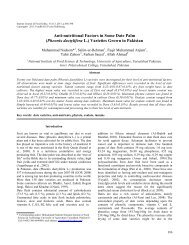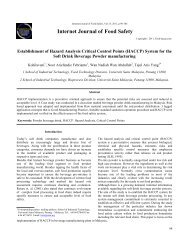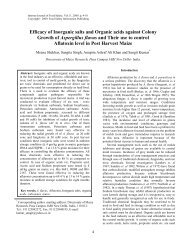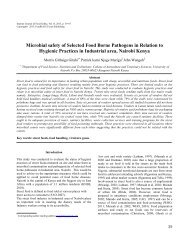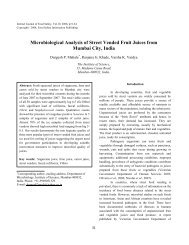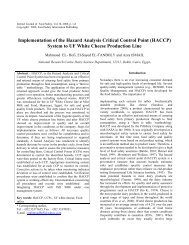Vol 13.351-354 - Internet Journal of Food Safety = FoodHACCP.com
Vol 13.351-354 - Internet Journal of Food Safety = FoodHACCP.com
Vol 13.351-354 - Internet Journal of Food Safety = FoodHACCP.com
You also want an ePaper? Increase the reach of your titles
YUMPU automatically turns print PDFs into web optimized ePapers that Google loves.
<strong>Internet</strong> <strong>Journal</strong> <strong>of</strong> <strong>Food</strong> <strong>Safety</strong>, <strong>Vol</strong>.13, 2011, p.351-<strong>354</strong><br />
Copyright© 2011, <strong>Food</strong>HACCP.<strong>com</strong> Publishing<br />
Effect <strong>of</strong> Gamma Irradiation on the Extraction Yield<br />
and Microbial Contamination <strong>of</strong> Medicinal Plants<br />
Prakash Chandra Gupta 1 , Neelam Garg 2 *, Prakash Joshi 1<br />
1<br />
Microbiology Laboratory, Homoeopathic Pharmacopoeia Laboratory, Ghaziabad - 201 002, India<br />
2<br />
Department <strong>of</strong> Microbiology, Kurukshetra University, Kurukshetra - 136 119, India.<br />
Abstract<br />
Medicinal plants normally carry high bio-burden due to their origin, <strong>of</strong>fering potential hazards to the consumer. In the<br />
present study Terminalia chebula, Curcuma longa, Syzygium aromaticum and Mentha piperita were irradiated to gamma<br />
rays at doses 2.5, 5.0, 10.0, 20.0 and 25.0 kGy. The microbiological quality <strong>of</strong> irradiated and un-irradiated medicinal plants<br />
was assessed by counting the number <strong>of</strong> total aerobic mesophilic bacteria, yeast and molds, and coliforms. The gamma<br />
irradiation at a dose <strong>of</strong> 2.5 kGy resulted in 2 log reduction in total aerobic mesophilic bacterial count except Syzygium<br />
aromaticum. However, no yeast and molds, and coliforms were found after irradiation at 2.5 kGy. The Gamma irradiation at<br />
a dose <strong>of</strong> 5.0 kGy resulted in 5 log and 4 log reduction in aerobic mesophilic bacterial count <strong>of</strong> Terminalia chebula and<br />
Mentha piperita respectively. Complete sterilization was obtained at 10 kGy. The total extraction yield <strong>of</strong> the all the<br />
medicinal plants was increased by 0.5 to 25% by a dose <strong>of</strong> 25 kGy. This study indicates that gamma irradiation increases the<br />
extraction yield and is an effective treatment for microbial decontamination <strong>of</strong> medicinal plants.<br />
Key words: medicinal plants, gamma irradiation, microbial contamination<br />
Introduction<br />
Despite tremendous advances in modern medicine, plants<br />
continue to make important contribution to health care as<br />
witnessed by the increasing interest in alternative therapies<br />
like Ayurveda, Unani and Siddha (Rates 2001). The<br />
properties <strong>of</strong> traditionally used drugs have been<br />
documented in detail in “Ayurveda”, one <strong>of</strong> the sacred texts<br />
<strong>of</strong> the Hindu philosophy. It is the foundation stone <strong>of</strong><br />
ancient medical science <strong>of</strong> India followed by “Susruta<br />
Samhita” and “Charaka Samhita”. According to estimates<br />
<strong>of</strong> World health organization, plants are not just the main<br />
<strong>com</strong>ponent <strong>of</strong> traditional medicines but they also form up to<br />
about 70 per cent <strong>of</strong> the basis <strong>of</strong> modern pharmaceutical<br />
products. One example is acetylsalicylic acid, the main<br />
ingredient in pain killers, which was first extracted from<br />
domestic willow almost 150 years ago (Anonymous 2011).<br />
The use <strong>of</strong> medicinal plants as a remedy for various<br />
ailments among the tribals in India and world over is<br />
evident from various ethnobotanical surveys. As in<br />
Ayurveda many medicinal plants viz. Curcuma longa,<br />
Azadirachta indica, Emblica <strong>of</strong>ficinalis, Ficus benghalensis,<br />
*Corresponding author: mailing address: Department <strong>of</strong> Microbiology,<br />
Kurukshetra University, Kurukshetra - 132 119, India,<br />
Email: nlmgarg@yahoo.<strong>com</strong><br />
Terminalia arjuna, Ocimum sanctum etc. have been used<br />
probably as early as 1900 B.C. (Aggarwal et al. 2007).<br />
Medicinal plants are precious gifts <strong>of</strong> nature and are also<br />
used to develop characteristic aroma, colour and taste <strong>of</strong><br />
food.<br />
Medicinal plants are subject to deterioration by chemical<br />
and microbial processes during the harvesting, processing,<br />
storage and their distribution. Attempts have always been<br />
made to decontaminate and preserve these medicinal plants<br />
so as to get more safe, natural and potent medicines. The<br />
number <strong>of</strong> methods has been tried for decontamination such<br />
as heat treatment, UV irradiation and fumigation. However,<br />
volatility and heat sensitivity <strong>of</strong> the delicate flavor and<br />
aroma <strong>com</strong>ponents <strong>of</strong> the medicinal plants do not permit the<br />
use <strong>of</strong> heat treatment. Low penetration power <strong>of</strong> UV<br />
radiations makes this irradiation method unsuitable.<br />
Fumigation with gaseous ethylene oxide brings down the<br />
microbial burden but this method is now prohibited or<br />
restricted in many countries due to the carcinogenic nature<br />
<strong>of</strong> one <strong>of</strong> its residue in treated medicinal plants (Loaharanu<br />
1990; Dickman 1991; Uiji 1992). Consequently, a safe<br />
alternative hygienic technology is the need <strong>of</strong> the day.<br />
Various disinfectant technologies have been suggested<br />
which include electromagnetic radiations, photo-dynamic<br />
pulsing, ultrahigh pressure and CO2 treatment. Among the<br />
351
electromagnetic radiations, gamma irradiation is now<br />
gaining interest as one <strong>of</strong> the modern technologies for<br />
decontamination with wide range <strong>of</strong> applications. The<br />
source <strong>of</strong> gamma rays is radioactive elements either<br />
Cobalt-60 or Cesium- 137.<br />
Gamma irradiation is now getting recognition throughout<br />
the world as a phytosanitary treatment <strong>of</strong> herbal materials.<br />
It improves the hygienic quality <strong>of</strong> various herbal materials<br />
and reduces the losses due to microbial contamination and<br />
insect damage (Farkas 1998; IAEA 1992). Besides, it is a<br />
fast, safe, convenient, eco-friendly method which reduces<br />
the reliance on chemical fumigants and preservatives<br />
currently used by industries. The chances <strong>of</strong><br />
recontamination are also reduced, as it can be done after<br />
packaging. However, medicinal plants are still supplied<br />
without eliminating pathogens due to the lack <strong>of</strong><br />
information <strong>of</strong> various aspects like biological and chemicals<br />
effects.<br />
To our knowledge, adequate literature is not available on<br />
the effect <strong>of</strong> gamma irradiation on extraction yield and<br />
various microbiological parameters for Terminalia chebula,<br />
Curcuma longa, Syzygium aromaticum and Mentha piperita.<br />
Therefore, the present study is aimed at evaluation <strong>of</strong> the<br />
effect <strong>of</strong> various gamma irradiation dose levels on the<br />
extraction yield and microbial contamination <strong>of</strong> the<br />
medicinal plants.<br />
Material and Methods<br />
Plant materials. The Medicinal plants viz. Terminalia<br />
chebula Retz. (fruit), Curcuma longa Linn. (Rhizome),<br />
Syzygium aromaticum Linn. (Flower buds), and Mentha<br />
piperita Linn. (Leaves) were purchased from the local<br />
market in Ghaziabad, Uttar Pradesh, India and identified by<br />
botanists. The collected plant materials were air- dried for<br />
5-7 days under shade at room temperature, powdered with a<br />
grinder and packed in polythene bags.<br />
Gamma irradiation. The polythene packed pulverized<br />
medicinal plants (150 g each) were irradiated using gamma<br />
rays from a cobalt-60 source at room temperature. The dose<br />
levels applied were 2.5, 5.0, 10.0, 20.0 and 25 kGy. Unirradiated<br />
medicinal plants were used as a control.<br />
Enumeration <strong>of</strong> microorganisms. The microbiological<br />
methods were used from „protocol for testing Ayurvedic,<br />
Siddha and Unani medicines‟ (Anonymous 2007). Using<br />
pour plate method, samples (10g) were decimal diluted<br />
serially with saline solution and added to Nutrient Agar for<br />
total mesophilic bacterial count, Sabouraud<br />
chloramphenicol agar for total yeast and molds count and<br />
Mac-Conkey agar for total coliforms count. All these<br />
inoculated medium were incubated aerobically and<br />
respectively at 30 ± 2°C for 72h, 25 ± 2°C for 5 days and<br />
30 ± 2°C for 48h and colony-forming units (CFU) were<br />
counted.<br />
Sterility test. The sterility test was performed using<br />
Sabouraud dextrose broth medium for fungi and fluid<br />
thioglycollate medium for bacteria and incubated at 25 ±<br />
2°C and 32 ± 2°C respectively for 14 days.<br />
Extraction yield. The irradiated and un-irradiated<br />
medicinal plants (50 g each) were separately extracted in<br />
methanol using a soxhlet extractor. All the extracts were<br />
filtered through Whatman No. 1 filter paper and<br />
concentrated under vacuum at 45°C. Extraction yields were<br />
calculated using standard method (Khanzadi et al. 2008).<br />
Statistical analysis. All determinations were obtained from<br />
triplicate measurements and results were expressed as mean<br />
± standard deviation. The data were analyzed using oneway<br />
ANOVA and least significant difference tests for the<br />
mean differences between controls and irradiated samples<br />
for all the parameters. Statistical significance was declared<br />
at p < 0.05, or mentioned otherwise.<br />
Results and Discussion<br />
The total aerobic mesophilic bacterial count in the unirradiated<br />
medicinal plants were found to be in the range <strong>of</strong><br />
103 -106 CFU g-1 (Table1). Irradiation at a dose <strong>of</strong> 2.5 kGy<br />
resulted in 2 log reduction however, 3 log reduction was<br />
found in Syzygium aromaticum. The Gamma irradiation at<br />
a dose <strong>of</strong> 5.0 kGy resulted in 5 log and 4 log reductions in<br />
case <strong>of</strong> Terminalia chebula and Mentha piperita<br />
respectively, however no mesophilic bacterial count was<br />
recorded in Curcuma longa and Syzygium aromaticum.<br />
Table 1. Effects <strong>of</strong> various doses <strong>of</strong> gamma irradiation on the total mesophilic bacterial count (CFU g -1 )<br />
Medicinal plant 0kGy 2.5 kGy 5 kGy 10kGy 20kGy 25kGy<br />
Terminalia chebula 3.5 x 10 6 2.5 x 10 4 6.7 x 10 1 ND ND ND<br />
Curcuma longa 2.1 x 10 3 1.8 x 10 1 ND a ND ND ND<br />
Syzygium aromaticum 1.6 x 10 5 5.2 x 10 2 ND ND ND ND<br />
Mentha piperita 2.8 x 10 5 3.8 x 10 3 3.5 x 10 1 ND ND ND<br />
a ND- Not detected (Detection limit > 10 CFU g -1)<br />
Data represent mean standard ±deviation <strong>of</strong> three measurements.<br />
Significant different p< 0.05<br />
352
The differences in sensitivity to irradiation among<br />
microorganisms might be due to the differences in their<br />
chemical and physical structure, antiseptic properties <strong>of</strong><br />
different plants and their ability to recover from the<br />
radiation injury (Jana Sádec ká 2007). The dose <strong>of</strong><br />
irradiation required to control microorganisms in medicinal<br />
plants, therefore, varies depending on the resistance <strong>of</strong> the<br />
particular species and the initial number <strong>of</strong> organisms<br />
present. The actual dose employed is a balance between<br />
what is needed and that what can be tolerated by the<br />
product without objectionable changes (e.g. <strong>of</strong>f-flavours,<br />
texture changes, flavour alterations).Furthermore, in the<br />
sterility test, at a dose <strong>of</strong> 5.0 kGy, Terminalia chebula and<br />
Mentha piperita showed bacterial growth on 5th and 7th day<br />
respectively whereas Curcuma longa, Syzygium<br />
aromaticum showed it on 11th day <strong>of</strong> incubation. A dose <strong>of</strong><br />
10 kGy or higher resulted in <strong>com</strong>plete sterilization <strong>of</strong><br />
medicinal plants and the sterility was maintained for 14<br />
days. Our previous study has also indicated that a dose <strong>of</strong><br />
10 kGy was required to obtain a product <strong>of</strong> good<br />
microbiological quality (Prakash et al. 2009).Table 2<br />
showed that the total coliform counts varied between 102<br />
and 104 CFUg-1 in the un-irradiated medicinal plants.<br />
Table 2 . Effects <strong>of</strong> various doses <strong>of</strong> gamma irradiation<br />
on different types <strong>of</strong> microorganisms.<br />
Dose <strong>of</strong> Gamma<br />
Type <strong>of</strong><br />
Microorganisms<br />
Initial Count<br />
(CFU g -1 )<br />
Irradiation (kGy)<br />
for <strong>com</strong>plete<br />
decontamination<br />
Coliforms 10 2 -10 4 2.5<br />
Yeast and<br />
Molds<br />
10 2 -10 3 2.5<br />
Mesophilic<br />
bacteria<br />
10 3 -10 6 10.0<br />
Data represent mean standard ±deviation <strong>of</strong> three<br />
measurements.<br />
Significant different p< 0.05<br />
However, no coliform was observed at even a lower dose <strong>of</strong><br />
2.5 kGy. Our results are in accordance with Owczarczyk et<br />
al. (2000) and Yu et al.(2004) who reported that gamma<br />
irradiation is an effective method for microbial<br />
decontamination. The total yeast and molds count was in<br />
the range <strong>of</strong> 102 – 103 CFU g-1 in the un-irradiated<br />
medicinal plants. The majority were yeasts, which are<br />
reported to be <strong>com</strong>mon flora on plant surfaces. However, no<br />
yeast and molds was found after irradiation at 2.5 kGy. This<br />
might be due to the fact that fungus is known to be<br />
relatively sensitive to gamma irradiation (Wills 1983)<br />
hence; a dose <strong>of</strong> 2.5 kGy <strong>com</strong>pletely eliminated the yeast<br />
and molds. All the air dried samples <strong>of</strong> medicinal plants in<br />
their native state were found to be contaminated with<br />
different types <strong>of</strong> microorganisms suggesting the need <strong>of</strong><br />
decontamination <strong>of</strong> medicinal plants to obtain safe products<br />
for medicinal usage.<br />
The extraction yields <strong>of</strong> all the four medicinal plants in<br />
methanol were determined at various doses <strong>of</strong> gamma<br />
irradiation and results are given in Table 3.<br />
Table 3. Effect <strong>of</strong> various doses <strong>of</strong> gamma irradiation on<br />
extraction yield (%, w/w) <strong>of</strong> medicinal plants.<br />
Medicinal<br />
plant<br />
0<br />
kGy<br />
2.5<br />
kGy<br />
5<br />
kGy<br />
10<br />
kGy<br />
20<br />
kGy<br />
25<br />
kGy<br />
Terminalia<br />
chebula<br />
59.91 60.2 63.5 66.4 72.8 74.9<br />
Curcuma<br />
longa<br />
35.64 35.94 36.8 38.8 39.4 40.9<br />
Syzygium<br />
aromaticum<br />
27.32 28.1 28.9 29.5 31.5 32.2<br />
Mentha<br />
piperita<br />
13.45 13.9 14.7 15.2 15.8 16.4<br />
Data represent mean standard ±deviation <strong>of</strong> three<br />
measurements.<br />
Significant different p< 0.05<br />
Terminalia chebula showed the highest extraction yield<br />
(59.91%), followed by Curcuma longa, Syzygium<br />
aromaticum and Mentha piperita with extraction yields <strong>of</strong><br />
35.64 %, 27.32% and 13.45%, respectively in unirradiated<br />
samples. After irradiation to gamma rays, subsequent and<br />
significant increase in the level <strong>of</strong> extraction yields was<br />
recorded in all the medicinal plants. The extraction yield in<br />
Terminalia chebula, Curcuma longa, Syzygium aromaticum<br />
and Mentha piperita methanol extract was increased from<br />
0.5% to 25.0%, 0.8 % to 14.7 %, 2.8 % to 17.8 % and 3.3 %<br />
to 21.9 % at 25 kGy gamma irradiation. The increase in the<br />
dry weights <strong>of</strong> extracts following irradiation, might be due<br />
to degradation <strong>of</strong> some high molecular weight <strong>com</strong>ponents<br />
or solubilization <strong>of</strong> some <strong>of</strong> the non-soluble <strong>com</strong>ponents <strong>of</strong><br />
the plant material which are now detected in the extract.<br />
The measured effect <strong>of</strong> irradiation was enhanced in the<br />
methanol extracts, which is able to extract both polar and<br />
semi-polar <strong>com</strong>ponents. These results confirm findings <strong>of</strong><br />
our previous study ( Prakash et al. 2010) and those <strong>of</strong><br />
Huang and Mau (2007) and Kim et. al. (2000) who have<br />
also reported an increase <strong>of</strong> 5-30% in the extraction yields<br />
<strong>of</strong> Korean medicinal plants, using various solvents, with a<br />
dose <strong>of</strong>10kGy gamma irradiation; however the difference in<br />
increase in extraction yields, as <strong>com</strong>pared to that reported in<br />
the literature might be due to different chemical<br />
<strong>com</strong>position <strong>of</strong> the plants.<br />
This study indicates that gamma irradiation technology has<br />
potential to improve microbial decontamination and<br />
extraction yield <strong>of</strong> the medicinal plants. Moreover, gamma<br />
irradiation is an effective technology for resolving technical<br />
trade issues for many food and agricultural products (WHO<br />
1994; FDA 2001). As a disinfestation treatment also, it is<br />
very efficient and has broad-spectrum control <strong>of</strong> many<br />
organisms including pathogenic and spoilage organisms to<br />
the acceptable microbial contamination limits in herbal<br />
materials and is one <strong>of</strong> few methods to control internal pests<br />
353
(FDA, 2001). Therefore, in the interest <strong>of</strong> the human<br />
welfare and for improvement in the quality <strong>of</strong> herbal<br />
medicines, gamma irradiation <strong>of</strong> the medicinal plants at a<br />
dose <strong>of</strong> 5kGy is very effective treatment prior to<br />
manufacture <strong>of</strong> medicines.<br />
References<br />
Aggarwal BB, Sundaram C, Malani N, Ichikawa H, 2007.<br />
Curcumin: the Indian solid gold. Adv. Exp. Med. Biol.<br />
595: 1–75.<br />
Anonymous .2011.Medicinal Plants: Biodiversity for health<br />
care. Available at:<br />
http://www.gtz.de/de/dokumente/en-biodiv-issuemedicinal-plants-2008.pdf<br />
(accessed August 15 2011)<br />
Anonymous. 2007. Microbial Limit Tests .pp.77-93. In<br />
Protocol for testing Ayurvedic, Siddha and Unani<br />
medicines. Department <strong>of</strong> AYUSH. Ministry <strong>of</strong> Health<br />
& Family Welfare. Pharmacopoeial Laboratory for<br />
Indian Medicines. Ghaziabad. India.<br />
Dickman S. 1991. Compromise eludes EC. Nature. 349:<br />
273.<br />
Farkas J.1998. Irradiation as a method for decontaminating<br />
food: A review. Inter. J <strong>Food</strong> Microbio. 44: 189–204.<br />
<strong>Food</strong> and Drug Administration. 2001. Bacteriological<br />
Analytical Manual (on line): Aerobic Plate Count.<br />
Gaithersburg.<br />
Gupta PC, Bajpai V, Mishra V, Saxena RK, Singh S.2009.<br />
Effect <strong>of</strong> gamma irradiation on microbial load,<br />
aflatoxins and phytochemicals present in Trigonella<br />
foenum-graecum. World J Microbiol Biotechnol.<br />
25:2267–2271.<br />
Gupta PC, Garg N, Pant D, Joshi P, Lohar DR. 2010.<br />
Antimicrobial activity and HPTLC pr<strong>of</strong>iling <strong>of</strong> Piper<br />
longum Linn. after microbial decontamination by<br />
gamma irradiation. J pure applied microbiol. 4(1): 69-<br />
77.<br />
Huang SJ, Mau JL. 2007. Antioxidant properties <strong>of</strong><br />
methanolic extract from Antrodia camphorate with<br />
various doses <strong>of</strong> γ-radiation. <strong>Food</strong> Chem. 105: 1702–<br />
1710.<br />
International Atomic Energy Agency (IAEA). 1992.<br />
Irradiation <strong>of</strong> spices, herbs and other vegetable<br />
seasonings. A <strong>com</strong>pilation <strong>of</strong> technical data for its<br />
authorization and control. IAEA-TECDOC-639.<br />
Jana Sádec ká.2007. Irradiation <strong>of</strong> spices – a review. Czech<br />
J. <strong>Food</strong> Sci. 25: 231–242.<br />
Khanzadi FK, Thomas JS , Ihasnullah. 2008. Effect <strong>of</strong><br />
gamma irradiation on the extraction yield, total<br />
phenolic content and free radical-scavenging activity<br />
<strong>of</strong> Nigella sativa seed. <strong>Food</strong> Chem. 110 : 967–972.<br />
Kim MJ, Yook HS, Byun MW. 2000. Effects <strong>of</strong> gamma<br />
irradiation on microbial contamination and extraction<br />
yields <strong>of</strong> Korean medicinal herbs. Radiat. Phys. Chem.<br />
57: 55–58.<br />
Loaharanu P.1990. Role <strong>of</strong> irradiation to facilitate<br />
international trade in pepper. Paper presented at the<br />
15th Peppertech and 2nd Pepperexim Meet. Convened<br />
by the International Pepper Community (IPC). London,<br />
UK, 21–25 May, p. 19.<br />
Owczarczyk HB, Migdal W, Kedzia B. 2000. The<br />
pharmacological activity <strong>of</strong> medical herbs after<br />
microbiological decontamination by irradiation. Radiat.<br />
Phys. Chem. 57: 331–335.<br />
Rates SMK. 2001. Plants as source <strong>of</strong> drugs. Toxicon. 39:<br />
603-613.<br />
Uiji CH. 1992. Beating the bugs. Int. <strong>Food</strong> Ingred. 3: 9-12.<br />
Wills PA. 1983. Radiation microbiology in food<br />
preservation. pp 19-26 In: Proc. Natl. Symp. Ionizing<br />
Energy Treatment <strong>of</strong> <strong>Food</strong>s, Sydney, Australia, 5-6<br />
Oct 1982.<br />
WHO. 1994. <strong>Safety</strong> and nutritional adequacy <strong>of</strong> irradiated<br />
food. World Health Organization, Geneva.<br />
Yu YB, Jeong IY, Park HR, Oh H, Jung U, Jo SK. 2004.<br />
Toxicological safety and stability <strong>of</strong> the <strong>com</strong>ponents <strong>of</strong><br />
an irradiated Korean medicinal herb. Paeoniae Radix.<br />
Radiat. Phys. Chem. 71: 115–119.<br />
<strong>354</strong>


